Throughout the year, Catersource magazine has been gathering information about our industry in a variety of ways. We’ve generated surveys, presented and attended conferences, and listened to hundreds of industry leaders express their opinions about the challenges and joys they are experiencing in their markets. With a years’ worth of information to disseminate, certain topics have risen to the top. Let’s have a look.
Acquisition, training, retention: good news/bad news
One of the overarching concerns expressed this year relates to staffing: How to hold onto employees during the lean months, how to retain good employees, how to motivate, how to reward, how to compensate them, and how to find temporary workers.
Chefs bemoan the lack of qualified kitchen help; business owners want more dedicated and confident salespeople; front of house needs more servers; back of house needs people to plate.
Why is there such an issue finding qualified help in 2015? The good news: enhanced revenue. Catersource can point to its July 2015 readership survey, in which over 80% of respondents offered that they expected their companies to show positive-to-significantly-higher growth in 2016. This is up by about 3% over our previous survey, conducted in mid-2014.
Additionally, almost 75% of respondents to our 2015 survey said they had already seen an increase in their businesses by mid-year 2015—again, up by about 3% over 2014. Finally, examining our reports from a year ago, the number of events being catered has increased by about 2%. 2015 survey respondents as well as event professionals quotes in Catersource magazine pointed to three top areas of growth for 2016: an uptick in wedding business, more venue contracts, and a surge in corporate catering, be it drop off box lunches or an increase in corporate spending for holiday gatherings. Congratulations!
But with growth—increased business, et al—comes the need for more employees. Staffing events is definitely a collective thorn throughout the food service and event industries. What’s the solution? In a series of round table discussions in late 2015, industry leaders looked at the question, "How do you handle part time staffing for extreme high volume times" as well as acquiring and motivating qualified help any time of the year.
Chefs spoke to keeping relationships with departing workers friendly, as they might return to work an occasional event for quick cash, as well as encouraging employee reciprocity within non-competitive markets. Executives spoke of the many ways they recruit and interview, including university job fairs, employee referrals, using online systems such as Craigslist/Gigs or shiftgig.com; employing pre-interview questionnaires via SurveyMonkey and offering specific times each month for basic walk in interviews. All agreed that rewards and recognition are very important and run the gamut from doughnuts in the office to company “bucks” programs that employees can trade in for merchandise and gift cards, and quick cash incentives, such as rewarding the first salesperson to book an event in a specific week, or $50 for a five star review on Yelp.

Acquiring, training, and retaining qualified help is one of the more taxing concerns facing the hospitality industry today. Here, staff from Duvall Events, Charleston, SC, set up a red snapper crudo station. Photo by Alex Quijano
Ta ta! to personalized tastings?
Read any bridal magazine or hit on any nuptial website and you will see flagrant touting of The Tasting. Brides and grooms—you deserve it, and if it isn’t to your liking, ask for another!
According to most catering companies, however, tastings are the proverbial fly buzzing around a beautiful banquet table. Tastings are expensive, and unless the cost to produce is offset by a fee (one executive shared that he charges $200 a head for tastings), both sales staff and chefs alike are taxed by offering this service to potential clientele.
So, how is it being handled in 2015? Comments and suggestions from industry leaders range from banning personalized tastings and only offering group tastings; customizing the entree in group tastings but keeping the dessert and hors d'oeuvre stations the same with potential for upsell; and facilitating tastings only after the venue has been booked—never before. Another suggestion: offering a tasting no more than four to six weeks prior to the event to keep food costs accurate and the menu seasonally appropriate.
Another company mentioned that they schedule group tastings every first Wednesday of the month. Yet another trains all staff on the tasting stations to spread the workload throughout the company. At the far end of the spectrum, one caterer made the decision to discontinue tastings completely. They say they have not experienced any decline in their bookings.
Off-peak pricing strategies
How often have you said this in a staff meeting: “We’re good at filling those Saturday nights. How do we fill the rest of the week?” Another common 2015 industry conundrum. Fill those dates and your sales will rise even further. Let’s look at comments Catersource recently gathered from top industry executives:
> If they don't have the money for an in-season wedding, we try to push them to January. We charge less depending upon the season.
> We lower our minimums and then throw in amenities to make it a better value.
> Signature pricing, signature level. Then if you want a Sunday or Friday, it's classic pricing—and the menu is scaled down accordingly.
> We know we will book our Saturdays. Peak pricing starts at $179++. However, guests will get the same experience for Fridays and Sundays at a lower price. It is easier and more efficient for us to make and staff the same experience. You know that hotel room you stay in is the same any night of the week, but you're going to pay more for it if it's New Years Eve or the Super Bowl. We follow the same strategy.
> I sell one product. We offer consistent products and our menus change seasonally, though the proteins are similar. Friday and Sunday we serve exactly the same food as Saturday. However, it’s $25 less for a Friday or Sunday. For that, I'm going to charge you my cheap price. It evens out.
> In the off-season, I do low-priced weddings. I would rather keep my core people and break even in order to hang onto my staff.
> We tell the potential client we can make the same thing happen, you just need to change your date. Be flexible. What date do you want? OK—that date is $179. But this date? It’s $149.
> We hold meetings every week and ask sales, “what's the reaction out there?” If the date gets closer and it hasn't booked, we will discount.
> Our sales people are empowered to offer a ton of additional decor on ‘off’ nights instead of discounting food. The décor we have stocked—it’s not going to cost us anymore; we’ve already bought it. The food—not so much.

Filling Saturday nights is generally not an issue—but Fridays and Sundays are a different beast altogether. Shown: Connecticut Wedding Group; photo: CMC Photography
Food trends 2015
You can survey all the restaurateurs around, but if you want to know what is trending in catering, you need to talk to catering chefs. So—we did just that. We asked about a dozen chefs from top catering companies around the U.S. and Canada where they find inspiration, and what they’re cooking up in the kitchen in 2016.
As we noted in our January 2015 issue, molecular gastronomy was taking its leave. Chefs agree—“it’s challenging and not profitable,” one said, while the rest of group exchanged knowing nods. However, if you want to impress the guests with a little smoke and mirrors, “people lose their minds over liquid nitro meringues.” Liquid nitrogen is easy to work with and impresses the guests. Editor’s note: If you would like to see liquid nitrogen in action, click the link below for a short on-the-spot video I filmed of Executive Chef Matt Greene of Duvall Events, Charleston, NC, freezing lime wedges for use as garnish. If you have difficulty viewing it, use your Safari browser.
Fresh and local: Yes, it has been proven that local has outmaneuvered organic as of late. But local, chefs assert, isn’t necessarily the best. “I don’t necessarily want local prosciutto,” said a New England-based chef, “I want the best prosciutto!” Eating local is a tough trend to employ in catering for yet another reason: small local farms might have enough short ribs to supply a restaurant for a dozen or two meals each evening, over a series of months. But can they supply enough short ribs for 300 people on one night? While we are on the subject of farms, farm-to-table is great…but dirt-to-table is even better. Think herbs snipped right from a pot and muddled into a cocktail, microgreens pulled and garnished onto a plate, or tender lettuce leaves cut from a flat and tossed in front of the guests. In July at Tales of the Cocktail in New Orleans: pluck an herb, hand it to the bartender, and watch him incorporate it into your cocktail. It can’t get any fresher than that. Photo by Kathleen Stoehr Vegetables & grains: Sunchokes and Brussels sprouts are on a comeback; the raw and crunchy trend is making headway. Radishes and baby beets being are shaved at stations—and guests love it. Millet is the go-to grain, farro is still popular, and chia seeds are on the rise. Another hot button: heirloom grains and legumes grown using original pre-Civil War seeds (check out ranchogordo.com or rareseeds.com for inspiration) because people want to know: what did these foods taste like when our grandparents, or even their grandparents were eating them? Considering that the United Nations designated 2016 as International Year of the Pulses (go to iyp2016.org for more info), there really couldn’t be a better time to embrace this trend. Mini vegetables, micro-garnishes, and herbs are popular to accompany and enhance the enduring trend in small plates. A market in Harar, Ethiopia displays assorted pulses for sale. Pulses are a group of 12 crops that include dry beans, dry peas, chickpeas, and lentils. They are high in protein, fiber, and various vitamins. Most popular in developing countries, they are becoming recognized worldwide as part of a healthy diet. Photo: axel Fassio for IYP2016. Chef Rachanee Keovorabouth, Thomas Caterers of Distinction, assembled a spinach, chickpea, and carrot salad with prosciutto chip for attendees at the Art of Catering Food in Salt Lake City. Photo by Alex Quijano The lemongrass garnish is set first into the vessel for this scallop tasting at Art of Catering Food 2015. Photo by Alex Quijano Brussels sprouts are not just popular to eat—they make a great little bouquet on smaller tables | Duvall Events, Charleston, SC. Photo by Kathleen Stoehr Dietary restrictions: “Gluten-free is huge,” the chefs agreed. “And while celiacs want to be accommodated, they don’t want to pay for it.” Soy allergies are on the rise. “Gluten-free has become a nightmare for our pastry chef,” one chef noted. Here’s a way to work with the myriad of restrictions. A Midwest chef noted, “The client will give you a laundry list of all the things they can’t eat. That’s too difficult. Instead, have them tell you what they do eat. Once I did that, I looked at the list and said, ‘Oh! Well, I can work with that.’” Yet another chef stressed starting the discussion early, in the initial meetings with the client. Have your salespeople broach the topic of dietary restrictions and how they are handled within company, well before the tastings start. “Because this whole thing will get worse and worse unless we take control of it. These same people were eating our meals five years ago without complaint,” one chef asserted. Sous vide: In 2014, it came in dead last on our survey about various cooking techniques. Yet, we knew it was on the rise, saying, “keep your eye on this technique because—that’s the thing about trends: they take time to get rolling.” Sure enough, we saw sous vide in use and demonstrated in Salt Lake City at August’s Art of Catering Food, and at our chef roundtable in November it was emphatically stated that: “Sous vide is really a trend in the industry. I use it a lot, actually, for short ribs, roast beef, chuck flat.” Utah Valley University’s Chef Todd Leonard, CEC, sliced up pork loin cooked sous vide then finished on the stovetop, for attendees at Art of Catering Food. Photo by Alex Quijano What guests love: Spectacle. Craft cocktails are hot. So how about barware moving to the savory side? One chef mentioned seeing a salad bar with attendants dressed like bartenders, agitating oil and vinegar in a cocktail shaker. Interactivity. Get a few spin art machines and use food paint in squeeze bottles such as raspberry gel to decorate a plate prior to the cake slice being served. Or put some of the hottest sauces (Thai sweet chili, Sriracha ranch, gochujang aioli, roasted red pepper ketchup) into squirt bottles for squeezing over a plate of spuds. Customization: Bars of all kinds are favored by guests: a yogurt toppings bar at breakfast; salad-style snack bars with hummus and cut vegetables; mashed potato and pasta bars replete with cheeses, sauces, and garnishes; even a cocktail garnishes bar—we pour the drink, you garnish it…and then tweet your creation out to your followers (be sure to print a hash tag on your cocktail napkins!). At Catersource in March, buff tuna carvers fired up Sterno to create tuna street tacos—and a flurry of Instagram-worthy images. Photo by Alex Quijano At a Duvall Events-catered party at the Boone Plantation in Charleston, NC, guests were up to their elbows in boiled shrimp and roasted oysters, shucking, slurping, and chucking the shells into an opening mid-table. Interaction and camaraderie were at an all time high. Photo by Alex Quijano In Portland, ME at the International Foodservice Editorial Council meetings, attendees were invited to garnish their cocktail with a variety of Sunkist citrus garnishes, from wedges to peels to slices. A mashed potato bar offering plenty of customized toppings delighted many a guest at a meet-and-greet in Portland, ME. What chefs want: As one chef put it, “Anything cool that anybody ever sees ends up on Pinterest—though it might not be so cool when you have to make it for 300 people.” Pinterest aside, chefs don’t just look at ingredients and recipes; they want interesting vessels, too. “What am I going to serve it on?” one chef questioned. “What are we presenting it in?” Chefs talked about how they love to find a new vessel, “and then I will think about what I can put in there.” They pointed to the tradeshow floor at Catersource in Las Vegas for seeing the newest catering vessels, as well as retailer JB Prince, the blog: forums.egullet.org, and chefsroll.com. “If I feel dull,” said one southern U.S.-based chef, “I check out the top restaurants. I might get a whiff of an idea, a certain ingredient I hadn’t thought about. But I do think caterers start the trends, not restaurants. Look at the short plate trend—it started with us. So I also look at catering websites for inspiration.” Proof of the Pudding’s Executive Chef Vagn Nielsen (right) and Chef Scott Barham Morgan (left) created deconstructed Tuna Niçoise in small tuna-style cans for an industry gathering at Duvall Events in Charleston, SC. Photo by Alex Quijano Still going strong: Craft cocktails (especially barrel aged), locally crafted beer, and hard cider still rule—though watch as nonalcoholic beverages and artisan soft drinks command more space on menus; sausages and charcuterie plates continue to rise; breakfast and brunch (as I mentioned in our last issue) are very hot and speak to luxury and leisure at any time of the day; pickling and fermenting persist in their march to the top; chicken and waffles show no sign of leaving us. In fact, fried chicken is in its renaissance at the moment, a part of the comfort food movement that is also on the rise. New words for consumers: crudo, kalette, rillette, matcha, sumac. Parting is such sweet sorrow: I leave you with this final thought: you will know that a trend is on the wane when it becomes a Halloween costume. So, Sriracha, you have been wonderful, but when I saw that kid at my door with the green cap on his head and a red tunic emblazoned with your name, I knew it was time to say farewell. Hello, Gochujang! 

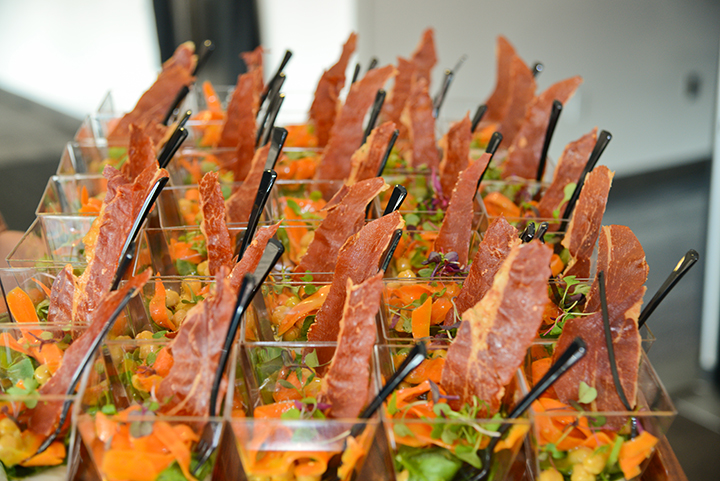
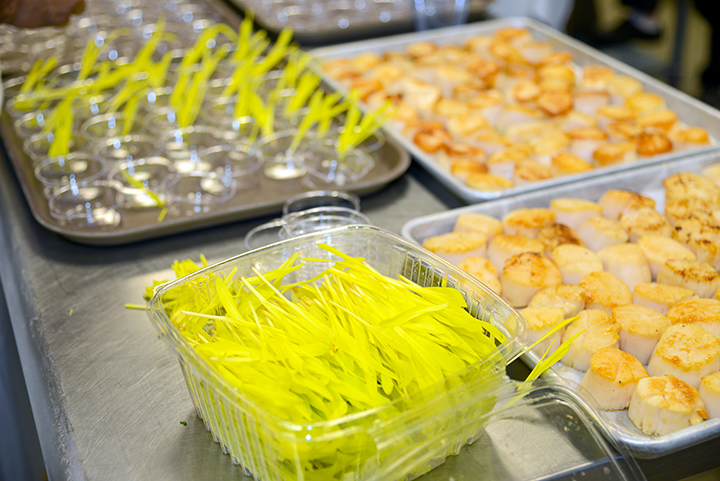
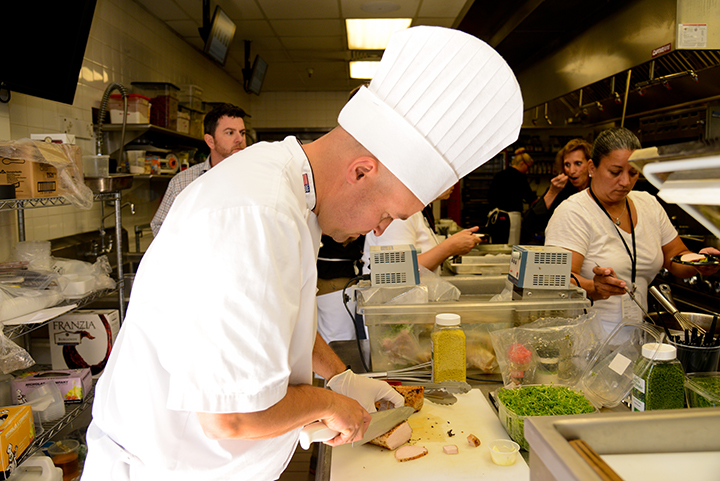

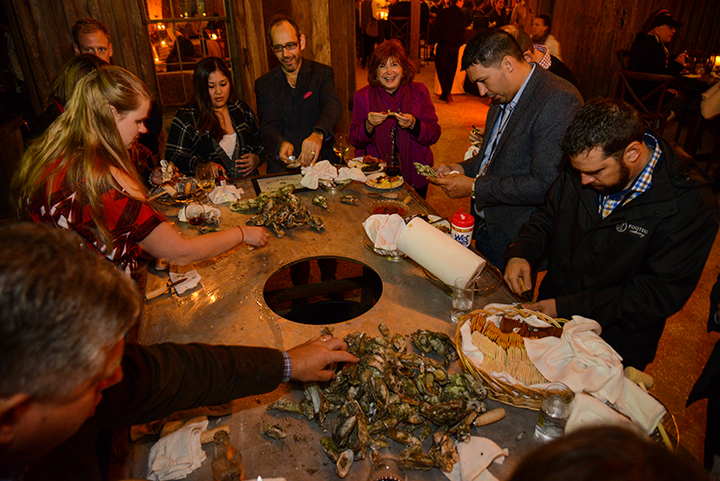
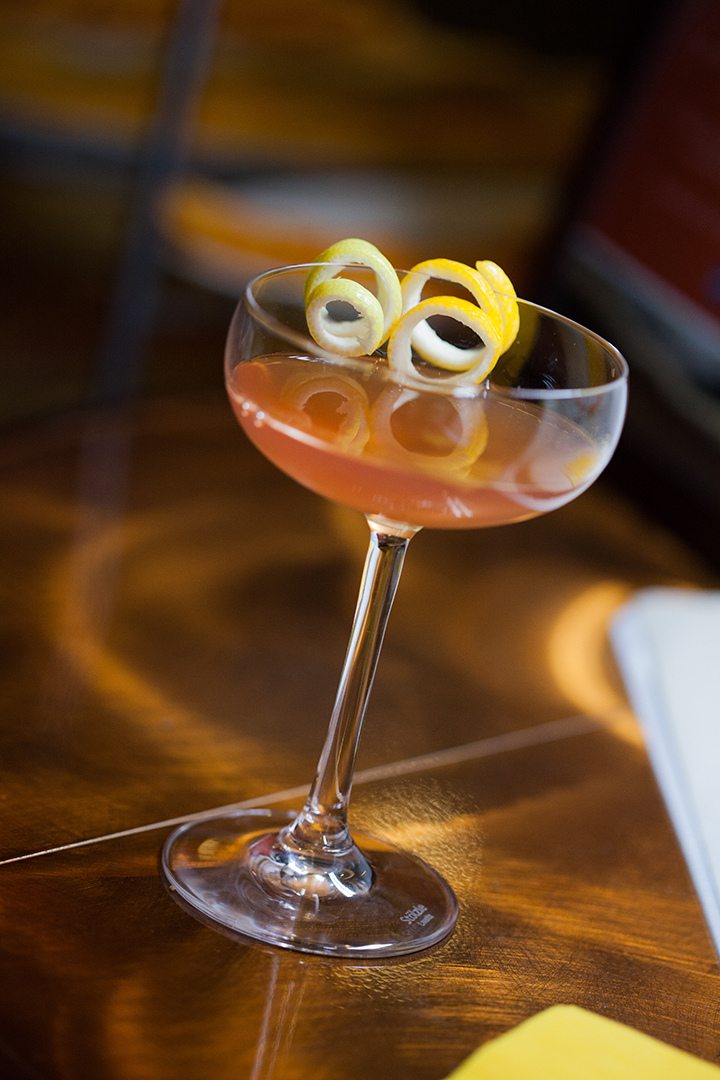
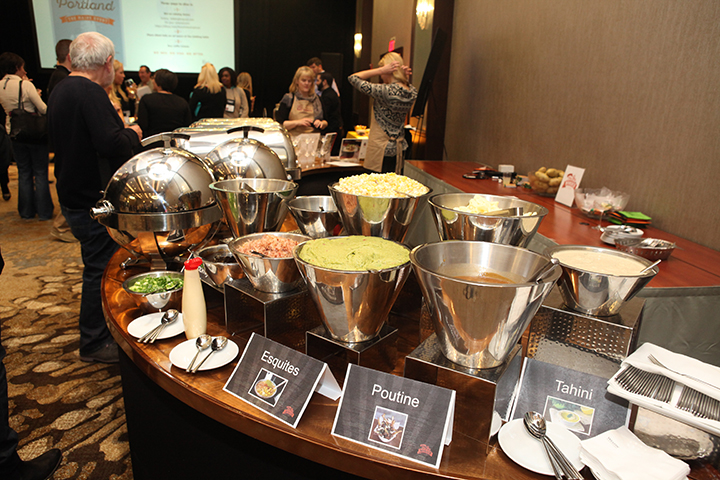
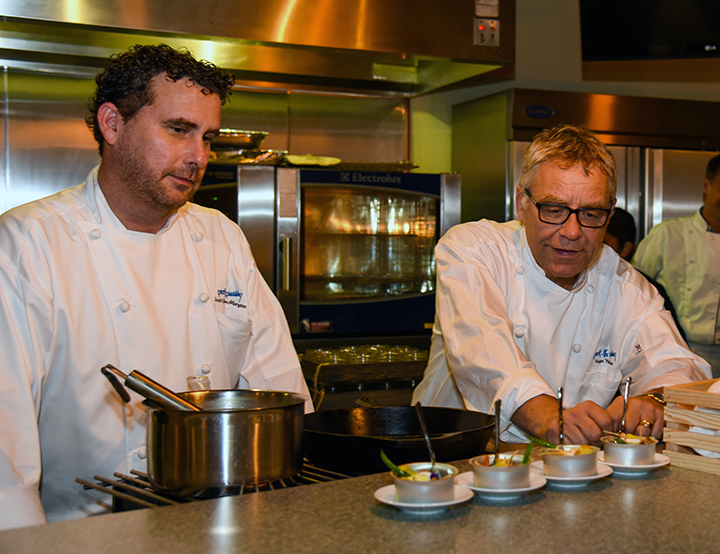
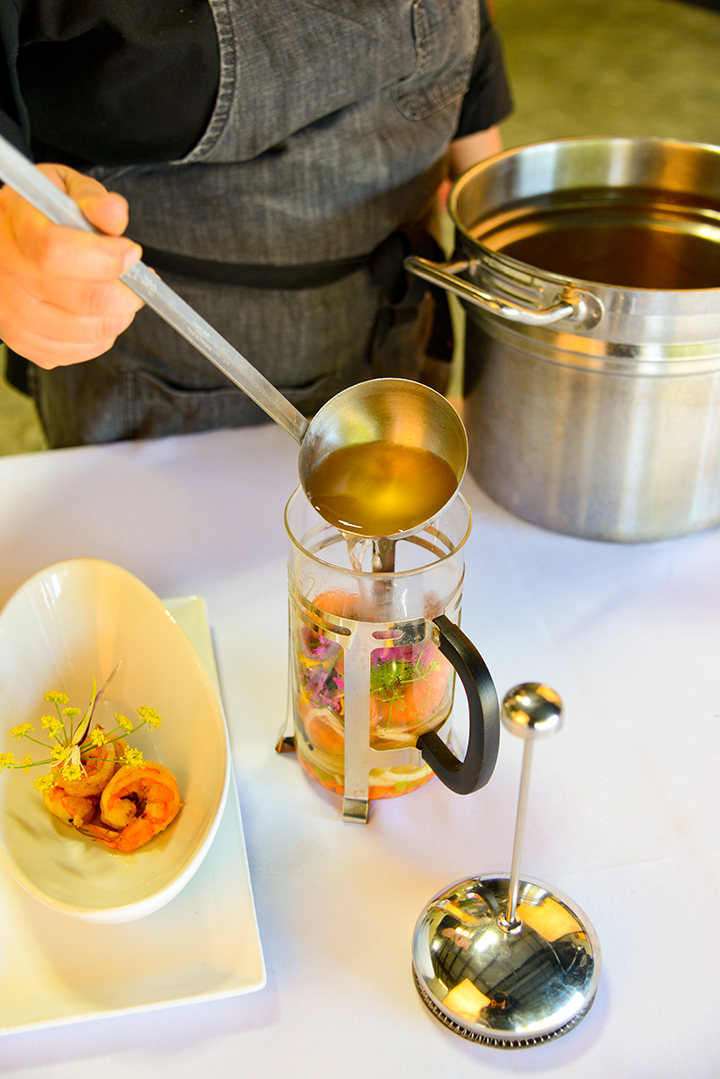 Chef John Walsh used a French press when creating and serving shrimp stock Photo by Alex Quijano
Chef John Walsh used a French press when creating and serving shrimp stock Photo by Alex Quijano  Ashley Santo Domingo used an immersion coffee brewer to infuse vegetables in a seminar she presented at Art of Catering Food. Photo by Alex Quijano
Ashley Santo Domingo used an immersion coffee brewer to infuse vegetables in a seminar she presented at Art of Catering Food. Photo by Alex Quijano



